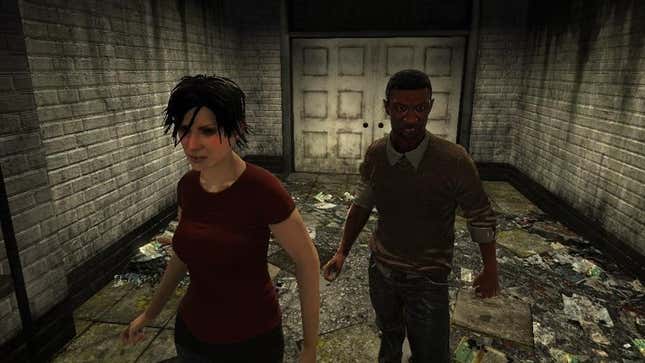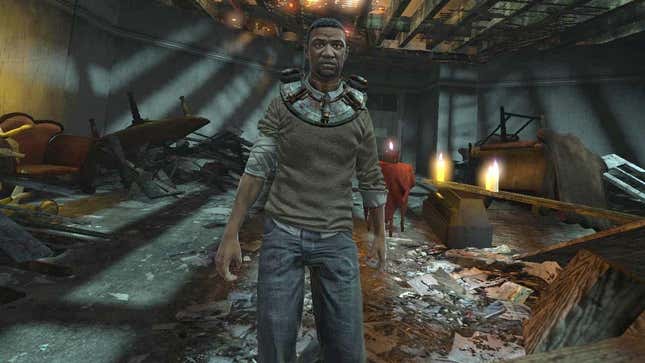I’m seeing Saw X tonight. The ever-wearier death game horror movie franchise has been toying with soft reboots since 2017’s Jigsaw and 2021’s Chris Rock-led Spiral, but neither really got the series back off the ground. Saw X is a prequel injected between the 2004 original and its 2005 sequel, and marks the first time since 2006’s Saw III that Tobin Bell’s John “Jigsaw” Kramer—the serial killer with delusions of grandeur big enough to fill a 10-film franchise over the course of two decades—has enjoyed a starring role not facilitated through flashbacks. As a long-time fan I’m excited, but Saw X also has me thinking back on the two Saw video games that Silent Hill publisher Konami put out with Zombie Studios in 2009 and 2010. Those games were kinda lit, but also kinda shit.
It’s funny looking back at video game marketing campaigns years after pie-in-the-sky franchise dreams failed to pan out. While Konami said it wanted Saw to be its next big horror franchise alongside Silent Hill we only ended up getting two games, meaning Konami killed the concept faster than one of Jigsaw’s victims. But given how fast and loose the games played with the Saw storyline, it was probably for the best that Konami didn’t keep poking and prodding at John Kramer’s legacy.
How the Saw games fit into the greater series’ timeline
The Saw series is an interconnected web of mysteries. It’s fascinating that despite the sequels quickly fumbling the original’s philosophical underpinnings, they still put a ton of planning into their character relationships. For as vapid as critics might claim Saw and its elaborate, pornographic death machines to be, the series is obsessed with the human connections that facilitate John Kramer’s descent into madness. That’s part of what made Konami’s Saw games compelling as thought experiments, even if they still felt like they were grinding against the films’ meticulously set boundaries.
The first Saw game, for PlayStation 3, Xbox 360, and PC, stars David Tapp, the Jigsaw-obsessed detective played by Danny Glover in the original film. Konami’s Tapp is notably not played by Glover, and also doesn’t really look like him, but I digress. Tapp had been presumed dead in the Saw films for years before the game’s release, having gotten shot in the chest in the first movie’s climax. He’s even seen in memorial tributes to cops lost in Jigsaw’s wake. So Konami’s first game retcons all that by putting him in an elaborate death game in an abandoned asylum. But because the Saw franchise demands continuity remain airtight, you can probably guess how things end for him.
As per Konami, Jigsaw apparently saved Tapp from his gunshot wound just to trap him in the asylum, claiming Tapp’s obsession with catching the serial killer had robbed the detective of actually experiencing his life. And this is a Saw story, so we can’t have that. What better way to instill a new lease on life than putting you through a series of life-or-death tests?
‘I want to play a game.’ - Me, buying the Saw video game
What follows is tense but repetitive adventure-game-style puzzle solving, jump scares, and some stiff-as-hell combat, all framed with the grime and grit of Jigsaw’s nastiest games. Tapp sifts through syringe-filled toilets and dead bodies to search for a key item to free himself from a locked room, walks across broken glass in bare feet, and comes across several other victims as they navigate their own twisted games. All of this, just to give Tapp something to swing a rusty pipe at.

None of this feels particularly good to play, and not just because shit’s gross and Jigsaw operates exclusively out of dilapidated buildings guaranteed to give you tetanus. The movement and combat are clunky, the puzzles are so recycled that you know what you need to do the second you enter a room, and really the greatest challenge the game has to offer is in how grotesque it is to watch unfold. Saw tries to create a facsimile of what it’s like to be in one of Jigsaw’s games by incorporating pain as a mechanic, which means if Tapp’s hand dilly-dallies too long in that pile of syringes, he’ll nope out and you’ll have to start the sequence over again. The general unpleasantness persists both in vibes and in being mechanically cumbersome.
Saw shakes things up a bit in its more elaborate trap scenarios, such as one in which Tapp’s hooked up to a machine that injects him and another participant with antidotes to a slow-acting poison. To save you both, you have to time injections as the device reroutes liquids between the two of you, and it’s all very silly and video gamey.
Moments like this are when the struggles of adapting the Saw formula to a video game show their face. Most Saw traps are fairly straightforward. It doesn’t serve Jigsaw’s endgame if his victims must surmount obstacles beyond pain and a lack of willpower. Making puzzles that are distinctly video game-ass puzzles with challenges and fail states is part of the medium, which means that some of the Saw game’s most memorable moments are also some of its silliest. Those traps are where the game feels like it diverges from the Saw films’ most recognizable moments, but even they tend to rely on callbacks.
That’s because Tapp isn’t the only familiar face (or as close as Konami was able to make them look without using the likenesses of any of the film actors). Obi, one of the victims in Jigsaw’s deadly game in Saw II, makes an appearance. He’s revealed to apparently idolize Kramer, which also works as an explanation for why he helped kidnap the other players to force them into the game. But more significantly, Amanda, one of Jigsaw’s proteges and one of the best characters in the franchise, also shows up. Her appearance in Konami’s game is once again seemingly as a victim of Jigsaw’s games, rather than as a mastermind. As a long-time fan, these cameos and connections were interesting, but looking back now, they’re emblematic of the Saw video game’s larger problems.

Konami crafted what basically felt like a “greatest hits” theme park ride for the Saw series. The two games were like haunted houses in which pig mask-wearing actors would jump out and deliver familiar lines. It whips out old characters, death traps, and other callbacks with reckless abandon. Tapp wakes up in the Reverse Bear Trap that Amanda faced in the first film. The Venus flytrap-like Death Mask drives nails through victims’ heads just as it did Michael Marks’ at the beginning of Saw II. Tapp gets fitted with the same Shotgun Collar that killed Lynn Denlon in Saw III.
It’s not quite clear if the Saw games feel beholden to the iconography of the movies’ death traps or if they just don’t have any original ideas to bring to the table. It’s probably a little of column A and a little of column B, but it ultimately means Konami’s first stab at a Saw game echoes the larger problems that would afflict the movie series in its latter half. It pulls elements from the movies and splatters them on the asylum walls, but for much of the game’s runtime, it’s all just set dressing. The rapid-fire delivery of death and carnage centers Jigsaw’s elaborate death contraptions over the people who fall victim to them, and often leans into the grossest things it can make a player do for spectacle’s sake.
The Saw games fall into the same traps the movies did
Like in the later Saw movies, the stars of the Saw game aren’t the victims Jigsaw deemed in need of rehabilitation through violence, but the death traps he concocted to test them. The Saw series is easy to dismiss as torture porn, but its early films did a far better job of contextualizing who Jigsaw’s victims were before subjecting them to torment. It was subsequent entries like Saw 3D that seemed more interested in giving just a single character agency and putting all others in their orbit on the chopping block, just to advance the plot.

The Saw game is this same format stretched into a seven-hour experience. Dozens of people are trapped in the asylum, but the test is really for us. As Tapp, we fight other victims just trying to survive Kramer’s twisted game, only helping a handful of people through theirs. But much like the Saw movies, Jigsaw’s philosophy gets muddied as the scope increases. Jigsaw’s entire spiel is that because he lost his life to cancer, he grieves his own life and resents those who don’t cherish theirs. The point of his tests was, as he described it, to serve as a wake-up call for people just shambling through life without purpose. This is too quickly lost in the game.
Konami’s lone sequel, Saw II: Flesh & Blood, launched a year later in 2010 for PS3 and Xbox 360, but the announced Windows. It doubled down on the format of the original and received even worse reviews. If Konami wanted to make Saw an enduring game franchise, rather than emulating the movie’s annual release schedule, it should have adopted a longer development cycle to give the developers time to more meaningfully iterate on ideas. Saw X is going back to a time before shit went off the rails, so I’m hopeful that even if it can’t revamp a series that really needs a hard reboot, it can at least show that lessons have been learned in the decade since John Kramer was a household name.